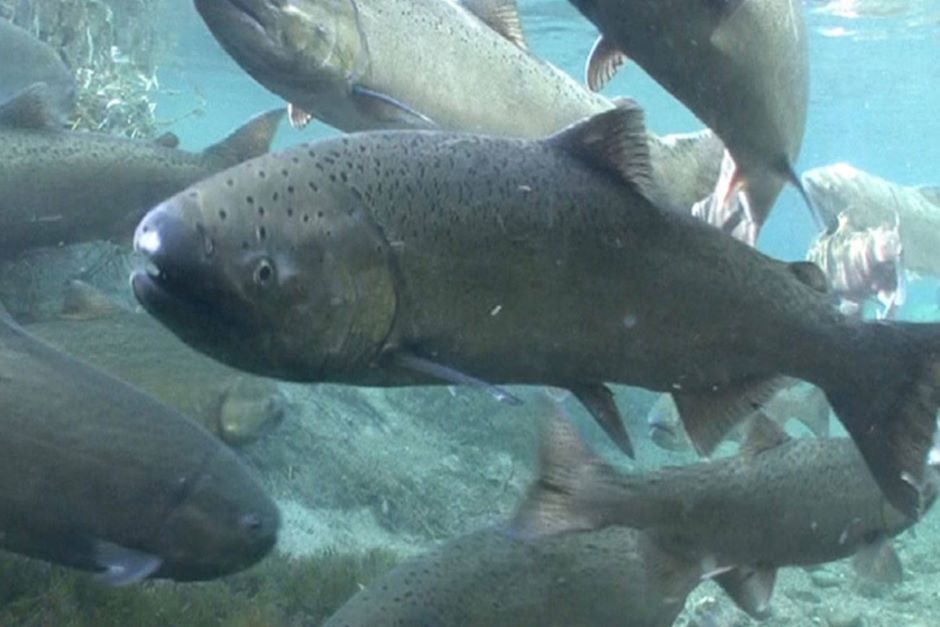Californian Salmon Drying Up In Drought
For the past several years, California has dealt with some of the driest seasons in American history, the height of which has started to impact the state’s salmon population. According to the State of California, in 2021, all 58 counties in California were placed under a drought emergency proclamation.
California relies on snow and rainfalls to provide a majority of the state’s water, but in years where snow and rain are less common, the state and its wildlife suffer. The state has had to restrict access to key waterways as a result of the drought.
In an article published by NBC, Todd Steiner, director of the Salmon Protection and Watershed Network (SPAWN), stated, “We’re in the second year of a drought here. It’s not doing the fish any favors. … We’re already talking about a critically endangered species on the verge of extinction, so this isn’t helping at all.”

Spring Chinook salmon (Credit: Michael Humling/USFWS, Public Domain)
Californian Chinook Salmon
Chinook salmon are a significant point of concern for California as they have gradually declined in population and been entered onto the protected species list. According to the NOAA, chinook have become endangered in the Sacramento River and the Upper Columbia River. California’s drought affects all wildlife, and with salmon already being at-risk, the heat is not helping these statistics.
Unfortunately, the drought has led to habitat losses and may have negatively impacted natural migration patterns. Salmon spend their lives migrating between fresh and saltwater biomes, but warm water may trigger early migration, harming the population.
Californian Coho Salmon
Coho salmon are also a species of concern in California. SPAWN has reported that the Central California Coast coho salmon population has declined more than 95 percent from historical levels. The remaining fish population has less ideal environments as the drought dries up watersheds and estuaries, leaving fewer spawn sites and habitats.
Stocking Salmon and Tough Decisions
Like many states facing biodiversity losses, California has attempted to repair damage through stocking. Considering there are so few natural-born salmon remaining in California, John McManus, president of the Golden State Salmon Association, stated, “A few years from now there’ll basically be no naturally spawned fish returning to the Sacramento River.”
California has had to restrict certain waterways to ensure citizens and agricultural access to water. These redirections may lead to a loss of habitats or raised water levels in dams and could threaten salmon’s ability to reproduce.
Even without the state-led changes to the environment, the higher temperature may lead salmon eggs to die off. “The federal government has told us we can expect river temperatures that are too high to sustain the eggs that will be laid this fall, which means we’re going to lose fish that would otherwise return three years from now,” McManus said in an article published by the Golden State Salmon Association.

A coho salmon schools with sockeye salmon in the Russian River, Alaska. (Credit: Ryan Hagerty/USFWS, Public Domain)
Natural and Artificial Habitats
Unfortunately, due to migration patterns, the true damage of the drought will be unknown for a few years as the state waits for salmon to hopefully return after their years in the ocean.
Notably, SPAWN has worked hard to create environments suited for salmon in hopes of protecting the fish. The “Roy’s Pools Fish Passage and Floodplain Restoration Project” removed a high-priority fish barrier and restored approximately 5 acres of creek habitats to help salmon.
The project is a joint effort by state, local, and national groups in order to ensure year-round management and access for salmon. The project also has begun the revegetation process of the area and created a .25 mile long flood plain for terrestrial wildlife to traverse.
Limitations in Protecting Californian Salmon
SPAWN has attempted to intervene and continues to work hard to create new habitats for Salmon to thrive in. The project is funded by the California Department of Fish and Wildlife, NOAA Restoration Center, and Turtle Island Restoration Network. Unfortunately, like all other fish, salmon require specific parameters for survival, and artificial techniques are limited in creating large and all-encompassing environments. The best hope for salmon in California is that the drought will break.

Pingback: FishSens Magazine | NOAA Research Links River Flow with Changes in Chinook populations - FishSens Magazine
Pingback: FishSens Magazine | Sacramento Chinook Salmon: Positive Population Trends - FishSens Magazine
Pingback: FishSens Magazine | Protecting Salmon Habitats for the Future - FishSens Magazine
Pingback: FishSens Magazine | How a California Watershed Sustains Salmon - FishSens Magazine
Pingback: FishSens Magazine | Vanishing Sockeye Salmon in Washington - FishSens Magazine
Pingback: FishSens Magazine | Making California's Yolo Bypass Salmon-Friendly - FishSens Magazine
Pingback: FishSens Magazine | Making Dams in California Fish-Friendly - FishSens Magazine